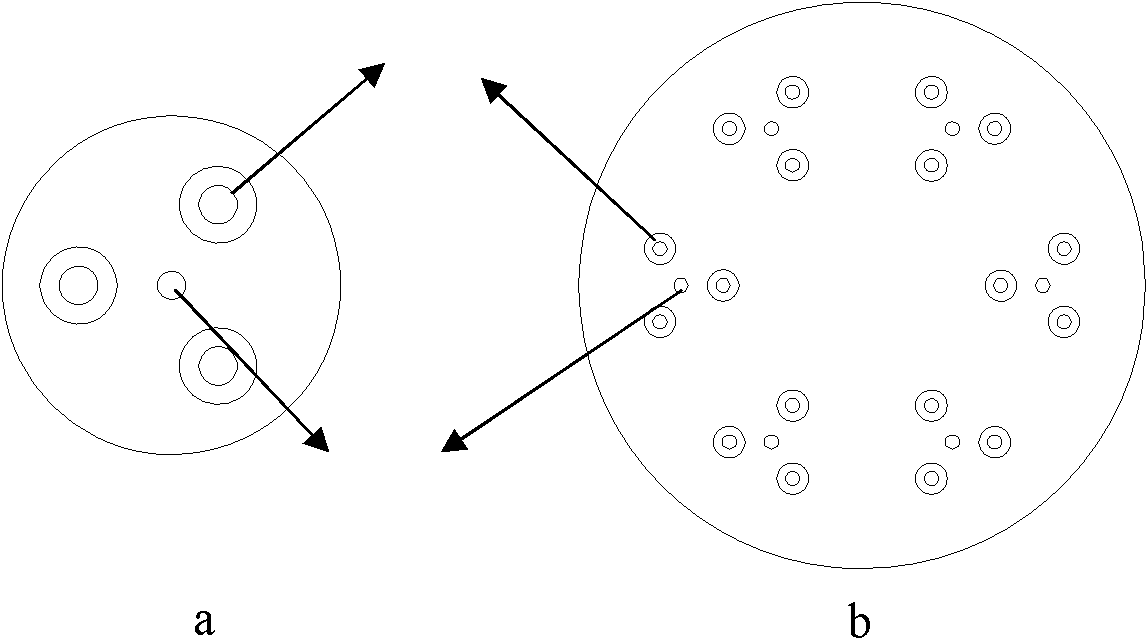Multi-core hollow fiber porous membrane and preparation method thereof
A porous membrane and fiber membrane technology, applied in the polymer field, can solve the problems of high pollution degree, damaged membrane filaments, reduced packing density, etc., and achieve the effect of improving the cleaning effect, meeting the requirements of use, and high tensile strength
- Summary
- Abstract
- Description
- Claims
- Application Information
AI Technical Summary
Problems solved by technology
Method used
Image
Examples
Embodiment 1
[0079] Stir 500g of calcium carbonate 2μm particles uniformly in 5kg of dimethylacetamide solvent under high-speed stirring, then add 2kg of dimethylacetamide, 2kg of polyvinylidene fluoride resin, 500g of polyethylene glycol, 100g of Tween-20, Stir to dissolve evenly, spin after defoaming. The above-mentioned spinning stock solution is subjected to such as Figure 5 The three-strand six-rib nozzle, together with the six-strand polyester rib, enters the coagulation bath to form a clustered hollow fiber membrane. The coagulant is water, the initial modulus of the polyester filament is 20-300cN / dtex, and the linear density of the polyester filament is 100-500dtex. The calcium carbonate in the polyvinylidene fluoride hollow fiber was removed with hydrochloric acid solution, and the obtained external pressure polyvinylidene fluoride hollow fiber porous membrane had an inner diameter of 0.5 mm, a wall thickness of 0.15 mm, and a shape that was not completely melted into a circle a...
Embodiment 2
[0083] Stir 500g of aluminum oxide 20-80 nanometer particles uniformly in 7kg of N-methylpyrrolidone solvent under high-speed stirring, then add 2kg of polyvinylidene fluoride resin, 500g of polyvinylpyrrolidone, 100g of Tuwen-80, stir and dissolve evenly, spinning after defoaming. The above-mentioned spinning dope is subjected to a process similar to Figure 5 The five-filament bundle and five-rib nozzle, together with the five-strand polypropylene rib, enters the coagulation bath to form a clustered hollow fiber membrane. The polypropylene yarn density is 100-500dtex. The coagulant in the coagulation bath is water. The aluminum oxide in the polyvinylidene fluoride hollow fiber was removed by NaOH aqueous solution, and the obtained external pressure polyvinylidene fluoride hollow fiber porous membrane had an inner diameter of 0.6 mm, a wall thickness of 0.15 mm, and a single hollow fiber membrane bundle breaking tension of 11.7 kg. Pure water penetration rate 870L / m 2 ·h@...
Embodiment 3
[0087] Stir 800g of calcium carbonate 2μm particles uniformly in 5kg of dimethylacetamide solvent, then add 1.8kg of dimethylacetamide, 1.8kg of polyvinylidene fluoride resin, 780g of polyvinylpyrrolidone, and 20g of fluorosurfactant FC-4, stir to dissolve evenly, spin after defoaming, coagulant in the coagulation bath is water. The 6 hollow fibers were bundled to obtain bundled hollow fiber membranes. Remove the calcium carbonate in polyvinylidene fluoride hollow fiber with hydrochloric acid solution, and obtain the external pressure polyvinylidene fluoride hollow fiber porous membrane, with an inner diameter of 0.6mm, a wall thickness of 0.15mm, and a rupture strength of 0.43MPa. A single hollow fiber membrane bundle is broken Tension 1.7kg, pure water penetration rate 1210L / m 2 ·h@0.1MPa 20℃, membrane separation pore size 0.50μm.
PUM
 Login to View More
Login to View More Abstract
Description
Claims
Application Information
 Login to View More
Login to View More - R&D
- Intellectual Property
- Life Sciences
- Materials
- Tech Scout
- Unparalleled Data Quality
- Higher Quality Content
- 60% Fewer Hallucinations
Browse by: Latest US Patents, China's latest patents, Technical Efficacy Thesaurus, Application Domain, Technology Topic, Popular Technical Reports.
© 2025 PatSnap. All rights reserved.Legal|Privacy policy|Modern Slavery Act Transparency Statement|Sitemap|About US| Contact US: help@patsnap.com



